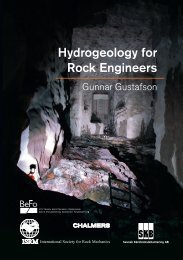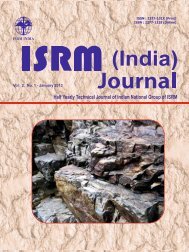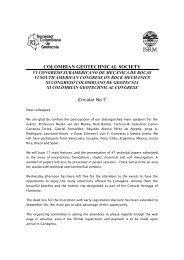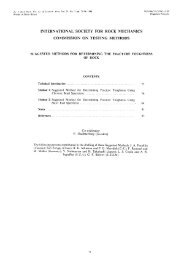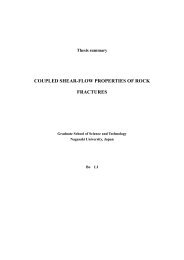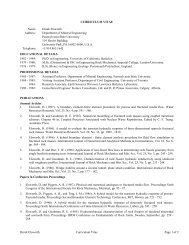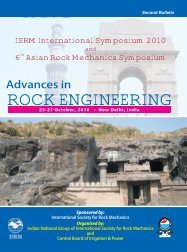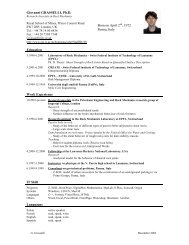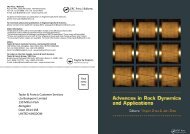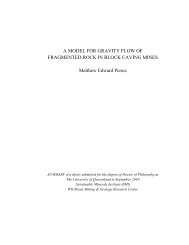ISSN : 2277-1328 (Online) - ISRM
ISSN : 2277-1328 (Online) - ISRM
ISSN : 2277-1328 (Online) - ISRM
You also want an ePaper? Increase the reach of your titles
YUMPU automatically turns print PDFs into web optimized ePapers that Google loves.
Study of Wellbore Stresses and Stability based on a Hollow Cylinder Model<br />
13<br />
The three failure criteria mentioned above, i.e., Mohr-<br />
Coulomb, Drucker-Prager and Modified Lade criterion,<br />
have been used in the analysis outlined above to predict<br />
the critical collapse pressure and tensile failure criterion<br />
has been used to predict the critical fracturing pressure.<br />
Then the results obtained from different failure criteria<br />
have been compared. Furthermore, the parametric<br />
analysis about the stress state and critical pressures has<br />
been conducted. Two ratios, the ratio of external and<br />
internal radius and the ratio of external and internal<br />
pressure, have been identified as crucial parameters that<br />
have significant influence on the critical internal pressure.<br />
To assess the influence of pore pressure on stability, the<br />
critical internal pressures have been estimated for two<br />
scenarios: with and without the pore pressure, and the<br />
big difference between these two cases has been<br />
observed. The set of rock strength and in situ stress<br />
data from one oilfield in the UAE has been used in<br />
calculations. It is shown in Table 1 where σ h<br />
is the in-situ<br />
horizontal stress, σ v<br />
is the vertical stress, and analysis<br />
has been performed in terms of two parameters α and β<br />
defined as<br />
R o<br />
= αR i<br />
and P i<br />
= βP o<br />
...(15)<br />
Table 1 : Rock properties and in situ stress data<br />
Depth σ h<br />
σ v<br />
P p<br />
S o<br />
β<br />
(m) (MPa/ (MPa/ (MPa/ (MPa) (degree)<br />
100m) 100m) 100m)<br />
2134 1.39 2.35 1.13 11.2 32.7<br />
3.1 Maximum Shear Stress<br />
The wellbore stresses σ r<br />
, σ θ<br />
and σ z<br />
were obtained by<br />
solving Eqs. 12-14. The three principal stresses σ 1<br />
, σ 2<br />
and σ 3<br />
were identified based on their magnitudes. Then,<br />
the maximum shear stress τ max<br />
was calculated as τ max<br />
=<br />
(σ 1<br />
-σ 3<br />
)/2. Fig. 4 shows the variation of τ max<br />
with the radius<br />
ratio α. As α increases, the maximum shear stress<br />
decreases, sharply at first and then remains approximately<br />
constant. Thus, the maximum shear stress τ max<br />
is very<br />
sensitive to wall thickness if the hollow cylinder is thin.<br />
Then a tiny increment in wall thickness can result in<br />
significant shear stress reduction. However, the maximum<br />
shear stress τ max<br />
is much less sensitive to wall thickness<br />
for the thick-walled cylinder. This can provide guidelines<br />
for scaling the laboratory hollow cylinder stress data into<br />
the real wellbore situation where α is infinite.<br />
Fig. 4 also shows the impact of β on τ max<br />
. As β decreases<br />
from 1.0 to 0, τ max<br />
will increase accordingly. In other words,<br />
the larger the difference between P i<br />
and P o<br />
is, the greater<br />
the τ max<br />
is. Therefore, if P o<br />
is fixed (such as in-situ horizontal<br />
stresses) and the internal well pressure continues<br />
decreasing (such as mud weight-related drilling pressure),<br />
τ max<br />
in the inner wall will continuously increase until shear<br />
failure will occur.<br />
Fig. 4 : Maximum shear stress at R i<br />
as function of α and β.<br />
3.2 Minimum Internal Well Pressure<br />
Figs. 5 and 6 show the influence of failure criteria, radius<br />
ratios and pore pressure on the lower bound mud weight,<br />
which is the minimum internal well pressure required to<br />
maintain wellbore stable. Firstly, the influence of failure<br />
criteria on minimum internal pressure becomes quite<br />
obvious through comparing the two sets of curves. The<br />
Mohr-Coulomb criterion is the most conservative criterion<br />
and the Drucker-Prager criterion is the most nonconservative<br />
one. The Mohr-Coulomb criterion predicts<br />
the highest critical β. That is mainly because the Mohr-<br />
Coulomb criterion is a two-dimensional criterion that only<br />
considers σ 1<br />
and σ 3<br />
. Therefore, the strengthening effect<br />
of the intermediate principal stress is ignored and borehole<br />
strength is underestimated. However, the Drucker-Prager<br />
criterion gives us the lowest critical β. That is mainly due<br />
to its overestimation of the intermediate principal stress<br />
strengthening effect. The Modified Lade criterion is a<br />
moderate one that is between the above two extreme<br />
criteria as it seems to properly account for the influence<br />
of σ 2<br />
on rock strength. These results are consistent with<br />
the results obtained by Zhang et al [14] .<br />
Fig. 5 : The effect of failure criterion on β-collapse<br />
including pore pressure effects<br />
Volume 1 No. 2 July 2012




